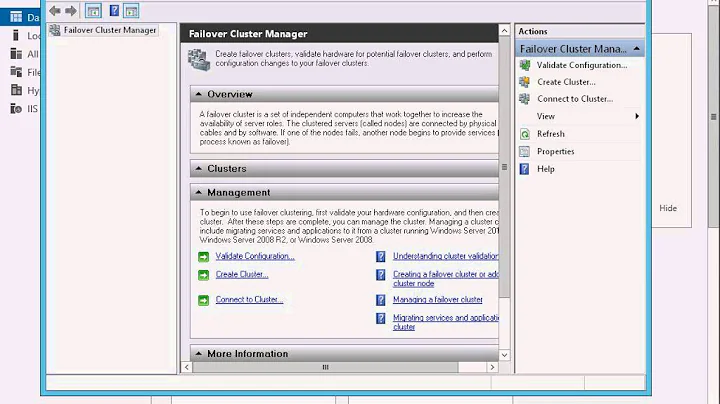Two-Node Server 2012 R2 Hyper-V Cluster: Is it possible use local physical disks in the cluster?
Solution 1
Failover clusters require shared storage. Without it, if a machine dies, the data on them is inaccessible and there's no way to failover without the data.
I don't believe there is any built in fault tolerant method of using the local drives. For clustered virtual machines, you need shared storage, and internal drives don't qualify.
What you can do, particularly if this is temporary while you are doing SAN maintenance or upgrades, is lose the fault tolerance. If you are using SCVMM, uncheck "Make this virtual machine highly available". If you are using the failover cluster manager, remove the virtual machine from the cluster manager (it will still exist on the physical host). Then use Hyper-V manager to move it to the local storage.
When you do this, you lose the fault tolerance - if a physical host dies, any VMs on that host go with it. You will still be able to use the non-clustered version of live migration to move them between hosts during normal operation - but it will mean moving the disk files too, so will take longer.
When you are done, move their disks back to shared storage and make them highly available again.
Solution 2
Not much to add here since StarWind and HP VSA are already mentioned! Both products provide great value and do exactly what you're trying to accomplish.
Keep in mind, you won't be able to shuffle the VMs back to local storage if it's already provisioned as storage pool for either HP VSA or StarWind. However, StarWind's storage is always available in loopback mode so you have access to your VMs even during maintenance. Not sure about HP VSA, there is a 3rd voting entity required for the cluster so the maintenance process can get more complicated.
If you have space reserve to shuffle the VMs - you can use Storage Live Migration functionality with any of the storage solutions available on the market.
Solution 3
StarWind Virtual SAN is pretty much everything you need. Unlike VM-running home-brewed solution GregL was mentioning this particular one is 100% native to Hyper-V as it's Windows app: simple to install and no VM patching mess. + performance. If you're fine with VMs take a look @ HP StoreVirtual VSA. It would be 1TB limited in capacity for their free version and ask for third stand-alone node to install FOM (Windows cluster witness equivalent).
Related videos on Youtube
gravyface
Updated on September 18, 2022Comments
-
 gravyface over 1 year
gravyface over 1 yearLooking at the following Clustered Shared Spaces TechNet article, and it looks like this only applies to hosts sharing a JBOD enclosure by way of external SAS backplane.
However, each host in the two-node cluster has an identical amount of SAS 15K drives (4), currently configured as a RAID 10 array.
I'm wondering if there's a Hyper-V equivalent to VMWare's Virtual SAN technology whereas local disks can be exposed as shared storage nodes on the cluster.
Basically we just want to make use of the disks on the host and the Failover Cluster Manager doesn't seem to want to play ball with the local disks as far as a target for moving a virtual machine. Would be nice for SAN maintenance to be able to shuffle VMs to the local disks as required.
-
 joeqwerty about 9 yearsThere are certainly third party software that can do this. I used StarWind Virtual SAN for this very thing as a temporary measure while I waited for shared storage to be purchased. Their free edition used to be "capacity capped" bit it looks like it's unlimited now.- starwindsoftware.com/starwind-virtual-san
joeqwerty about 9 yearsThere are certainly third party software that can do this. I used StarWind Virtual SAN for this very thing as a temporary measure while I waited for shared storage to be purchased. Their free edition used to be "capacity capped" bit it looks like it's unlimited now.- starwindsoftware.com/starwind-virtual-san -
 gravyface about 9 years@joeqwerty how long did you use it for? Stable?
gravyface about 9 years@joeqwerty how long did you use it for? Stable? -
 joeqwerty about 9 yearsWe used it for a few months. It was pretty stable. I don't recall having any issues with it.
joeqwerty about 9 yearsWe used it for a few months. It was pretty stable. I don't recall having any issues with it.
-
-
 gravyface about 9 yearsCompletely aware of the failover implications, just looking for temporary storage that's Hyper-V/VM-capable. Looking into SMB 3.0 shares.
gravyface about 9 yearsCompletely aware of the failover implications, just looking for temporary storage that's Hyper-V/VM-capable. Looking into SMB 3.0 shares. -
 Grant about 9 yearsTake a look at this page: technet.microsoft.com/en-ca/library/jj134187.aspx You might be able to get it to work over SMB3, kind of (particularly, loopback connections are not supported - so you have to have the storage on a separate server from the host, thus 2 single points of failure). But it won't be at all highly available without shared storage, so you are better off just switching the VMs to not be clustered and moving to the local disk.
Grant about 9 yearsTake a look at this page: technet.microsoft.com/en-ca/library/jj134187.aspx You might be able to get it to work over SMB3, kind of (particularly, loopback connections are not supported - so you have to have the storage on a separate server from the host, thus 2 single points of failure). But it won't be at all highly available without shared storage, so you are better off just switching the VMs to not be clustered and moving to the local disk. -
 gravyface about 9 yearsOh, yikes. Is the "clustered/non-clustered" option only available in VMM? We're just using the Failover Manager to manage the VMs at this point.
gravyface about 9 yearsOh, yikes. Is the "clustered/non-clustered" option only available in VMM? We're just using the Failover Manager to manage the VMs at this point. -
 Grant about 9 years@gravyface No, you can do it from failover manager and hyper-v manager. Just remove the VM from failover manager - now you have a non-clustered VM you can control in hyper-v manager. Add it back in failover manager and you are back to being clustered. Don't forget to move the disk/config files between local and SAN storage each time - failover cluster manager will not do it for you.
Grant about 9 years@gravyface No, you can do it from failover manager and hyper-v manager. Just remove the VM from failover manager - now you have a non-clustered VM you can control in hyper-v manager. Add it back in failover manager and you are back to being clustered. Don't forget to move the disk/config files between local and SAN storage each time - failover cluster manager will not do it for you.




